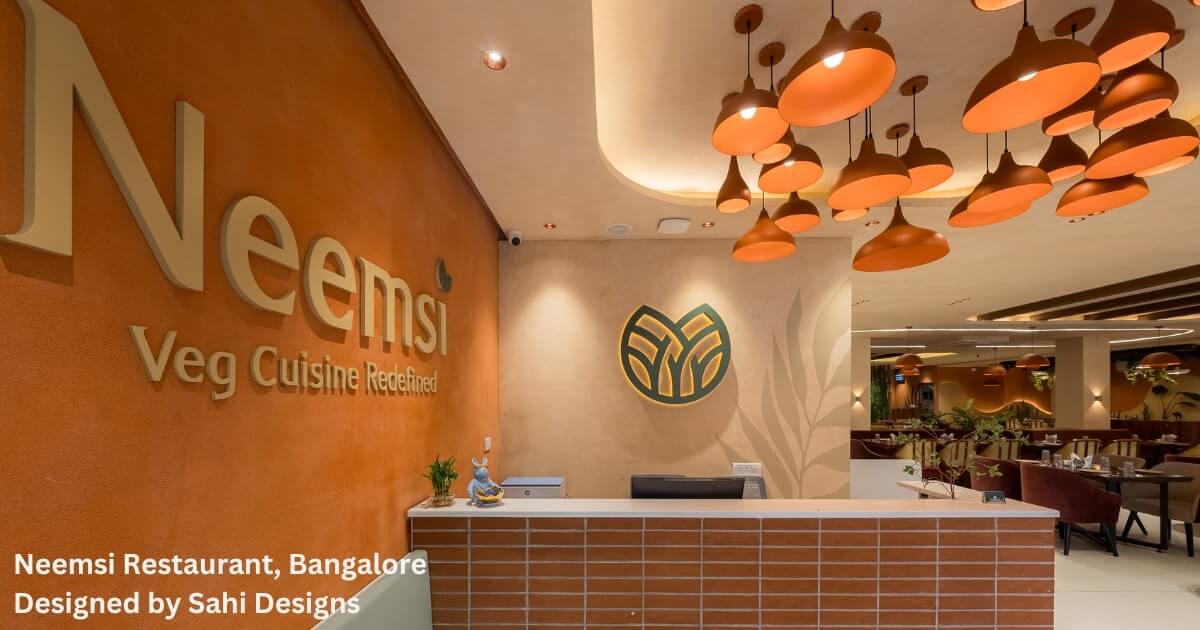We all have a particular taste for a certain kind of meal that we crave. A comforting bowl of pasta, a spicy thali, or maybe a perfectly brewed coffee. But how often do we let those cravings override the environment of the restaurant we choose to dine in? Very rarely.
With endless choices around us, the moment we step into a restaurant, we are already making silent decisions. If the space doesn’t feel warm, welcoming, or worth staying in within the first 7 seconds, we are already looking for the exit.
The truth is, it’s not the prices, the plating, or even the food that forms that initial impression. The restaurant business is about hospitality. It is about how your customer feels the moment they step into your business. It’s the lighting, the scent, the music, the decor, the overall vibe. That feeling of “Yes, this feels right” is what makes customers stay, return and recommend.
Simply put, how a space looks and feels matters, and that’s where interior design steps in. Let’s understand in detail.
What is Ambience and How is it Linked to Interior Design?
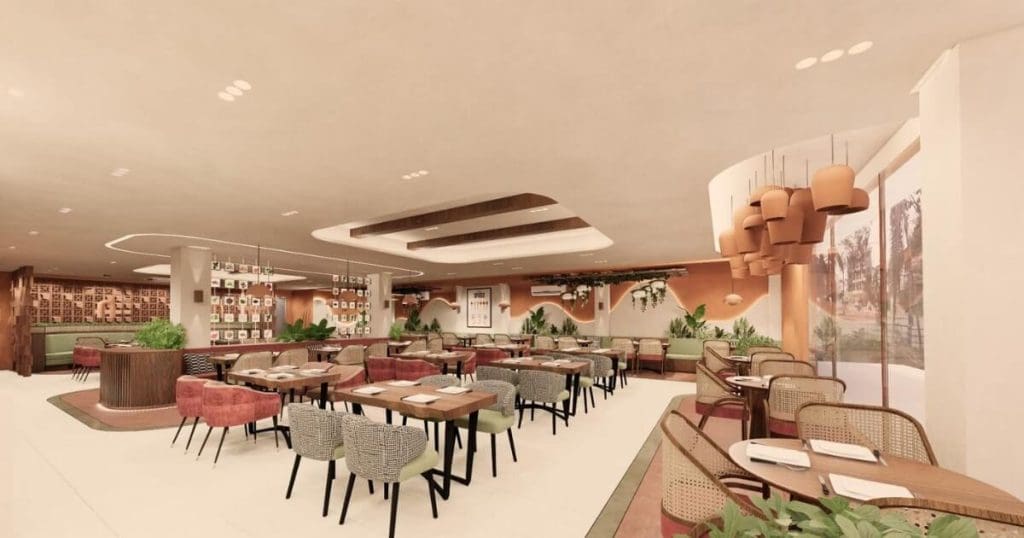
Ambience, in the context of a restaurant, refers to the overall character and mood of the space. This ambience is crafted through visual aesthetics, spatial arrangement, sensory cues, and emotional tone. Whether you call it atmosphere, environment, vibe or energy, it shapes how a customer perceives the dining experience before they take their first bite.
Elements such as lighting, acoustics, textures, colours, seating comfort, spatial flow, and olfactory presence (related to smell) all contribute to the ambience. These components work in sync to set the tone. Based on these elements, one can gauge whether a restaurant is relaxed and intimate, energetic and social, or elegant and upscale.
So, how is it related to interior design?
Interior design is what brings ambience to life with precision. It translates a restaurant’s philosophy, personality and purpose into a physical space. Every detail, from the size of the tables to the materials used on the walls, tells a story. The colours, the ceiling height, and the floor plan all deliver a message and elicit a response.
More than creating visual appeal, good interior design supports comfort, flow, and functionality. It ensures guests feel at ease, understood, and well taken care of. And when a space feels intentional and thoughtfully done, customers notice. It builds trust. It makes them want to return.
Ambience doesn’t happen by chance. It’s the result of clear design choices that align brand identity with customer experience.
How Interior Design Shapes the Customer Experience in a Restaurant?
The following are a few ways through which restaurant businesses can enhance their customers’ experience:
1. Light That Does More Than Just Illuminate
Lighting sets the emotional tone even before the food arrives. It influences pace, comfort, and how the space is perceived. Lighting could be warm and intimate or bright and buzzing.
What works:
- Use warm, diffused lighting for calm, cosy dining zones.
- Bright, focused lighting helps energise quick-service or cafe-style spaces.
- Accent lighting can highlight design details or featured decor.
Example: Starbucks uses soft, indirect lighting to create a relaxed space that encourages longer stays, while McDonald’s in India uses brighter lighting for fast customer turnover and high visibility.
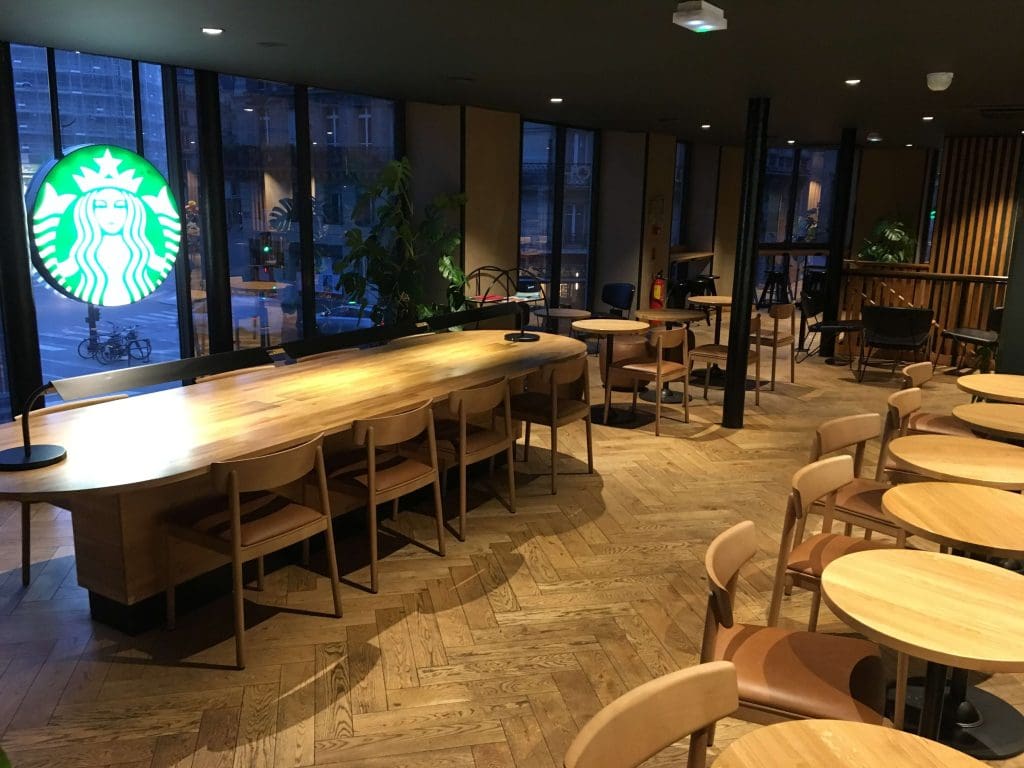
2. Layouts That Invite, Not Confuse
The way a space flows impacts everything from how guests enter and exit to how long they stay. Layout isn’t just about fitting tables; it’s about building comfort and clarity.
What works:
- Leave room around tables to avoid crowding, especially in finer dining setups.
- Create visual or spatial breaks between dining zones and service areas to enhance the overall dining experience.
- Design an intuitive entry, waiting, and exit path.
Example:The Bombay Canteen in Mumbai uses its layout to blend open seating, bar service, and private nooks. This way, they have created a space that feels both social and relaxed without feeling cluttered.
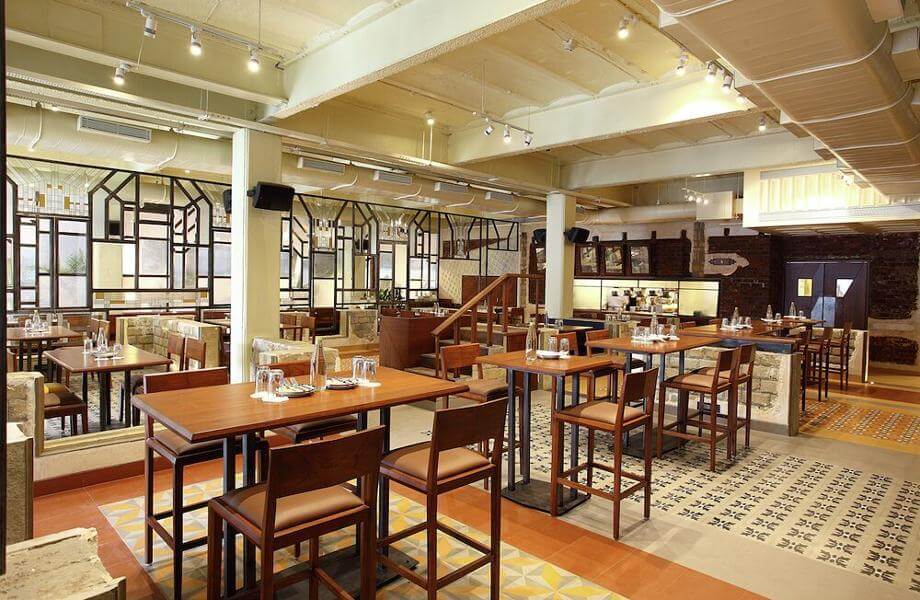
3. Seating That Encourages You to Stay or Move
Seating is misunderstood as filling a space. But it’s actually about comfort. It defines how a guest feels once they settle in. From materials to ergonomics, every detail affects comfort, posture, and pace of dining.
What works:
- Upholstered chairs or cushioned benches invite lingering; bar stools or minimalist setups suit faster turnover.
- Mix fixed seating (like booths) with movable furniture to allow flexibility.
- Backrest angle, cushioning and even legroom affect how long a guest will enjoy sitting.
Example:At Neemsi in Bangalore, the seating beautifully complements the earthy minimalism of the space. It combines natural textures with sculpted forms that encourage comfort without cluttering the visual palette.
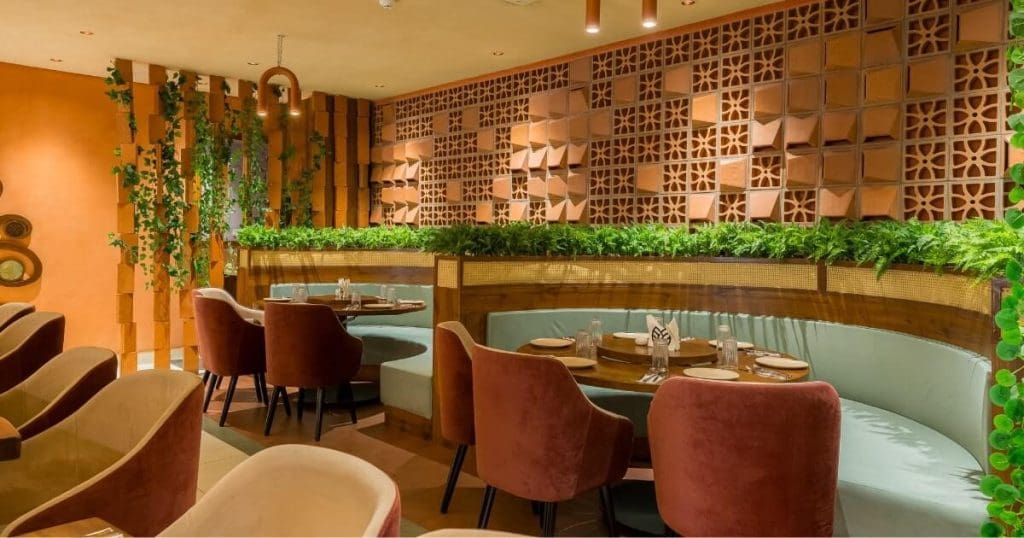
4. Furniture That Matches the Mood
Furniture plays a subtle yet powerful role in expressing a restaurant’s identity. More than functionality, it’s about what your choices say about your brand’s voice.
What works:
- Wooden tables with artisanal edges speak to rustic charm; marble or brass hints at luxury.
- Uniform furniture makes a space feel structured; eclectic mixes bring in personality.
- Materiality should reflect the tone. Whichever material you choose, whether cane, metal, leather, or laminate, they all have a story.
Example: At Bastian At the Top, Mumbai, the oversized leather chairs, marble-top tables, and custom brass finishes come together to create a bold, high-glamour dining space. The furniture offers comfort and elevates the entire dining experience. It reflects the restaurant’s indulgent, upscale character.

5. Colours and Textures That Speak the Brand
A space’s palette and material choices instantly convey whether it’s premium, playful, rooted, or experimental. These cues create a sensory link to your identity.
What works:
- Exposed brick, microcement, rattan, and tiles each bring a visual and tactile identity.
- Pick a lead colour and let surrounding tones either soften or highlight it.
- Use texture to add depth through walls, cushions or floor finishes.
Example: Bar Palladio in Jaipur uses layered royal blues, antique textures and Mughal detailing to create a luxurious, transportive atmosphere that’s impossible to forget.
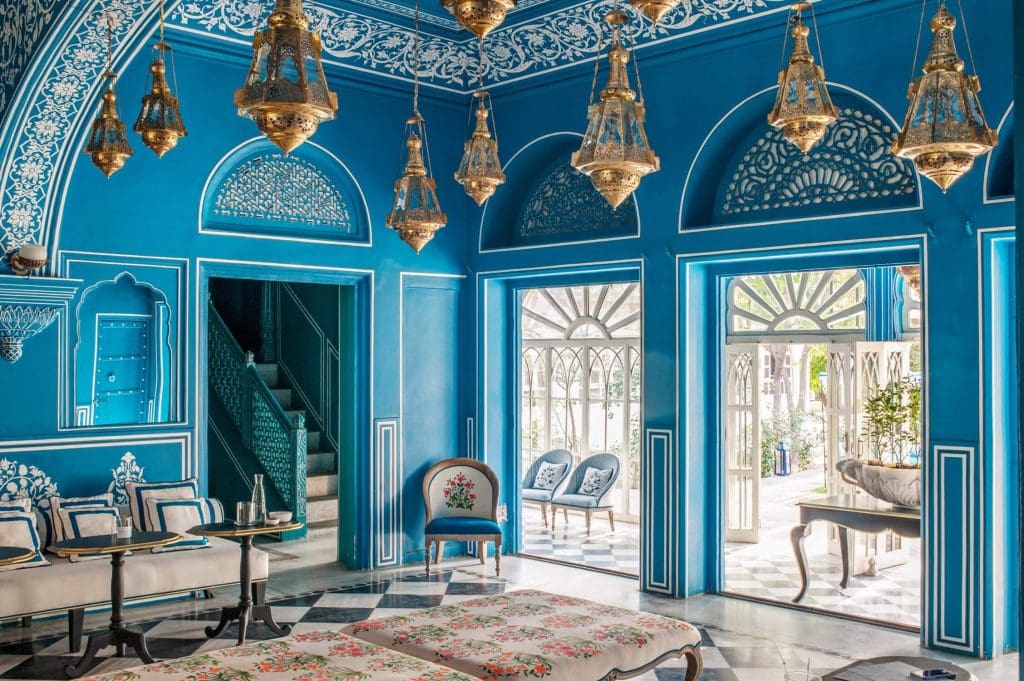
6. Sound That Doesn’t Compete with Conversation
Sound is an integral part of the overall comfort experience. A restaurant that looks great but is too noisy to talk in loses its charm. Acoustics help modulate energy without creating discomfort.
What works:
- Upholstery, curtains, ceiling baffles, or panels can reduce reverb.
- For busy restaurants, use layered materials to prevent echo.
- Background music and playlist selection must support the intended vibe.
Example:At Windmills Craftworks in Bangalore,designers combined plush sofas, wall-to-wall bookshelves, rugs and ceiling acoustics to balance live jazz performances with quiet conversation. Visitors often remark on the “near-hush” that prevails even during shows, which is proof that innovative design can support both atmosphere and intimacy at the same time.
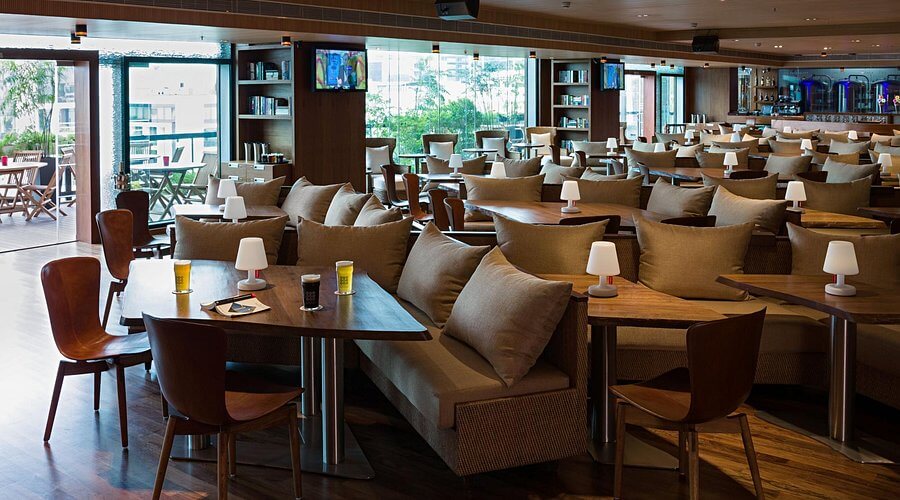
7. Details That Stay Long After the Meal Ends
It’s often the smallest touches that make a guest feel something that this space has been created with care and thought. These moments of design go beyond decor and into storytelling.
What works:
- Branded details in signage, menu layout, napkin design and cutlery trays.
- Scented entryways, curated wall art, and even the way the restroom looks and feels.
- The experience begins at the threshold and ends with the goodbye because every touchpoint counts.
Example:
Social outlets across India have mastered this, from industrial-chic interiors to quirky wall art and uniform branding across plates, coasters, and even bar taps. The details always feel deliberate, never random.
How Restaurant Interiors Drive Business?
Did you know that apart from aesthetics, a good restaurant ambience can also yield profits? Here’s how:
Increased Footfall: Visually appealing spaces naturally draw attention. A distinctive design often becomes a talking point, encouraging walk-ins and social shares, especially in high-footfall areas.
Longer Dwell Time: When customers feel comfortable, they stay longer. The right combination of seating, lighting and acoustics encourages them to relax, order more, and extend their visit.
Stronger Brand Recall: People remember how a place made them feel. A cohesive and well-executed ambience becomes part of the brand identity, boosting word-of-mouth and repeat visits.
Justifies Premium Pricing: An elevated environment creates a sense of value. When the space feels special, customers are more open to paying higher prices not just for food but for the experience as a whole.
Create Spaces Where Taste Goes Beyond the Food
Interior design in hospitality is about creating a space that is inviting, functional, and relatable. It not only needs quality design ideas but also a feel-good factor to encourage repeat footfalls. Hence, you must connect with our experienced and specialised restaurant interior designers at Sahi Designs. We design environments where aesthetics and function meet to support business, brand, and guest satisfaction.
